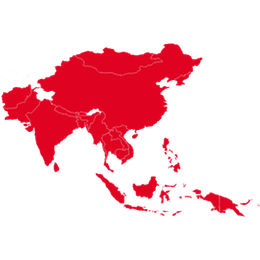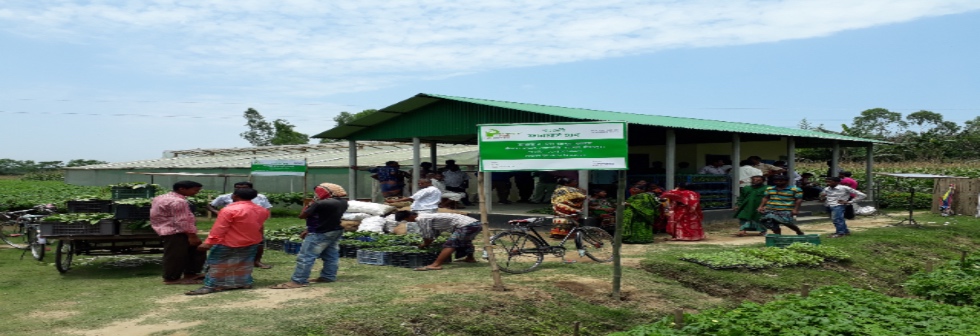Farmers’ Hub
“I find the Farmers’ Hub to be very reliable and trustworthy, which is very difficult to find in the market.”
A farmer, during the Impact Assessment by 60 Decibels in 2020BACKGROUND
Bangladeshi smallholders lack access to knowledge, good inputs, modern technology and markets. Rural youth have a negative view of farming. Companies find it hard to reach farmers. FHs create attractive jobs and provide farmers with the services and connections to earn better incomes.
WHAT’S INVOLVED
- Better use of resources and knowledge: Farmers' Hub operators provide crop husbandry advice, agriculture and market information for farmers.
- Market acces: Each Farmers’ Hub is established to serve 500-1,000 farmers and link them to 5-10 buyers, including medium-scale and large traders, agro-processing and export companies.
- Technology and machinery: The hubs provide rental services for agricultural equipment and sell inputs such as high-quality seedlings.
EXPLORE THIS SOLUTION
The Farmer's hubs can offer:
- Knowledge and services from hubs
- Better yields
- Increased incomes
- Social benefits
- Ecosystem building capacity

Countries involved
Bangladesh
Project partners
Syngenta
Project dates
2013 – Present
Share this solution
Bookmark this solution
BookmarkShow Full Solution
Summary
A Farmers’ Hub (FH) is a one-stop commercial service platform where smallholders can access quality agri-inputs, farm machinery, markets, finance, and knowledge. Under a franchise system, each FH is run by an educated young rural person who ensures the quality of services. To optimize business operations and connect relevant partners, FHs use a digital tool called eFarmersHub. Around 200,000 smallholder farmers currently get services from FHs in Bangladesh.
Challenge/Problem
Although smallholders are the key food producers in Bangladesh and other developing countries, few want to continue farming or would choose it as a profession for their children. Traditional farming and related activities hold little attraction for rural youth, who would rather migrate to urban jobs. There is significant gap between farmers in the productivity, profitability and preferences of smallholders. Their major constraints include:
- a lack of knowledge and information on proper crop husbandry and modern cultivation techniques, resulting in low productivity;
- limited access to quality inputs and farm mechanization services, leading to yield gaps and inefficiency; and
- poor access to markets and market information, a lack of active roles in the value chain, and small volumes of low-profit production.To accommodate a population 40 per cent larger than today’s, the world will need to produce 70 per cent more food. Making farming profitable, modern and attractive for current smallholders and the next generation is a key challenge. It needs to be tackled with modern tools, technology and strategies.
Solution
Keeping in mind the challenges of smallholders and rural youth, Syngenta Foundation for Sustainable Agriculture (SFSA) created the comprehensive Farmers’ Hub (FH) business model in 2013. SFSA has since standardized it through a franchise system to ensure quality of service across all FHs.
Each Hub is a well-structured aggregation point for nearby farmers. It offers facilities for buying and selling crops, renting machinery, purchasing quality inputs (such as soilless high-quality seedlings), engaging in post-harvest management (e.g. washing, grading, sorting, scaling, etc.) and obtaining agricultural and market knowledge. FHs are owned by educated young people from the community. Network managers prepare young people for FH business by providing training, strategy guidance, tools, raw materials and market linkages. Each Hub owner provides 3-5 services to 500-1,000 farmers for a fee. FHs earn 60-75 per cent of their revenue from trading farmers' products, 20-35 per cent from farm input sales and up to 5 per cent from machinery rental and post-harvest handling. FH owners manage their business using the eFarmersHub, a mobile enterprise resource planning (ERP) system that records all transactions, calculates farmers’ profits and tracks the FH’s finances and inventory. Marketplace and transaction analysis data also enable credit underwriting and demand forecasting.
FHs bring smallholders multiple advantages. Local services reduce transaction costs; quality inputs and advice help farmers increase their yields; rented machinery increases farm efficiency and output; and market links and information ensure fair produce prices. Others benefit, too: traders, processors and export companies get aggregated quality products from a single source. An FH is also an excellent platform for private and public organizations to manage outgrowers and promote technology. Under the franchise system, FHs are backed by research and development centres that identify suitable innovations for smallholders to modernize and commercialize their production.
Results
Farmers’ Hubs are one-stop commercial service platforms. They deliver quality services to farmers and link them to other value chain players. There are three main types of beneficiaries:
- Farmers: FHs have provided some 200,000 Bangladeshi smallholders with better knowledge, inputs, machines and access to markets. This package has increased average yields by 25 per cent and household incomes by 52 per cent while reducing post-harvest losses by 3-8 per cent. A monitoring report estimates that renting FH machinery reduces farm labour time by 80 per cent and costs by 60 per cent
- Micro-entrepreneurs: FHs create respectable and well-paying employment opportunities for educated rural youths in their communities. Some 285 rural youths operate FHs, creating jobs for 2,200 men and women Owners start their FH businesses by investing $2,000, enabling them to break even after about 18 months.
- Agricultural value chain players: Input and machinery companies as well as large exporters, processors and traders use FHs as aggregation points to reach large number of farmers without investing huge amounts of resources. Financial institutions can also use FHs for disbursing loans directly to micro-entrepreneurs and farmers. To assist with this, the eFarmersHub calculates credit scores.
Lessons Learned/Potential for replication
At the time of 2020, 285 FHs are operating in 12 districts in Bangladesh, serving 200,000 farmers in over 1,000 villages. At least 500 traders, seven agribusinesses, two machinery companies and more than 100 agri-wholesalers are connected with the Hubs. In addition, an estimated 50,000 non-associated farmers benefit indirectly.
Farmers’ Hub is a branded business model operated under a franchise system. Network Managers ensure the quality, standard and uniqueness of services. All services are backed by research and development and innovation. Brand, quality, trust and smallholder connections are key success factors for scaling this model in disadvantaged rural areas. The platform is always open for further players to create greater impact.
Hubs are a good service model for small and marginal farmers in remote regions. Organizing smallholders this way can greatly facilitate the production and collection of quality crops. It also improves compliance with quality standards.
Next Steps
Farmers’ Hub is an inclusive business model closely linking farmers, entrepreneurs, enterprises and private companies. Its franchise model ensures identical service quality across the network. Ensured profits are key to the model’s sustainability, but business flexibility and continued research and development also help.
FH has proved itself a commercially viable business in multiple countries. Building on the success in Bangladesh, the Syngenta Foundation (SFSA) team in Senegal launched its own Farmers’ Hubs at the end of 2017. Since 2018, SFSA has also piloted the FH model in Indonesia and Kenya and plans to replicate the model in other countries.
Solution Video
Solution Document Downloads
Last update: 25/06/2021



